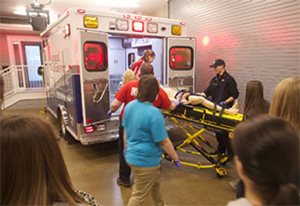AMT Dispatch Turns Into Learning Opportunity
Advanced Medical Transport (AMT) paramedics took part in simulations and training experiences at Jump.
 A Scary Situation
A Scary Situation
911, what's your emergency?
"My son just lost consciousness; he isn't breathing!"
We received the call for a six-year-old male in cardiac arrest early in the morning. Grabbing our equipment from the ambulance, we rushed into the house, bombarded by the screams of the mother, "He's not breathing!"
There wasn't much time. Should we immediately "load and go?" Should we start treatment right away on-scene? These were critical questions that needed answered using our training and experience.
The patient was hooked up to a monitor, oxygen was applied, advanced airway was established if needed, IVs were started, medications were administered, and the patient was defibrillated, all resulting in the return of spontaneous circulation (ROSC) of the critically ill child.
An Important Learning Experience Provided Through Simulation
Late last month, Advanced Medical Transport (AMT) held a total of 36 simulations across 3 days at Jump. All of AMT's full time paramedics were required to go through one of two simulations. The first, as told above, was for a six-year old boy in cardiac arrest. The other was for a two-year old with a suspected Tricyclic Antidepressant (TCA) Overdose.
The simulations were held in our Regional Transport Center, which includes an AMT ambulance and a one-bedroom apartment. High-fidelity manikins played the roles of the six and two-year-old, and actors, known as standardized participants, played the parents.
The purpose of the simulations was to give medics a realistic experience, starting with a dispatch call from 911 and ending with the radio call in to the receiving facility while en route to the hospital. They had to use their medical knowledge and teamwork to successfully complete the simulations; including being able to recognize multiple cardiac rhythms and apply advanced airway skills.
They were able to use most of their own equipment during the simulations, and simulated medicine was provided so that they could actually go through the process of measuring dosages and administering the medications to the high-fidelity manikins.
In addition to the simulations, each paramedic was rotated through various stations, including advanced airway placement with the use of King, oral, and nasal airways, IV and IO access, and case reviews.
"Emergency responders experience some of the most stressful situations in caring for patients," Dr. John Vozenilek, CMO of Jump said. "Recreating those conditions can be difficult, but it is so important in helping our emergency personnel enhance their skills and abilities to cope in such high-stakes situations. At Jump, we are proud to host these kinds of events, which help ensure our patients receive the highest quality of care. It's essential to our vision and to the OSF Mission to 'serve persons with the greatest care & love.'"
FEATURED AUTHOR
Kristina Sanders is the Simulation Manager for Jump Simulation and has been with OSF HealthCare since 2013. In this role, she leads a team providing education and operational support for faculty, clinicians and learners at the simulation center. Prior to her joining Jump, Kristi spent 14 years as a dispatcher and paramedic. Her extensive background provides a perfect foundation for health care education.